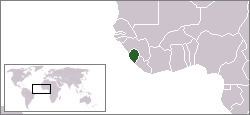 | ||
The Abidjan Peace Accord was a treaty signed in Abidjan, Côte d'Ivoire on 30 November 1996 to try to bring an end to the Sierra Leone Civil War (1991-2002). The two main signatories were President Ahmad Tejan Kabbah of Sierra Leone and Foday Sankoh, leader of the Revolutionary United Front (RUF) rebel group. However, Sankoh refused to honour the terms of the agreement, and Kabbah was forced into exile by a May 1997 military coup (though he regained power the following year), so the Accord failed to bring about peace.
Contents
Background
The civil war began on 23 March 1991, when the RUF attempted to overthrow the government of President Joseph Saidu Momoh. A 1992 military coup saw Captain Valentine Strasser, barely 25 years old, seize power, but the fighting continued. Strasser himself would be ousted by Julius Maada Bio in 1996. Peace negotiations were pursued intermittently through the regime changes.
On 25 February 1996, delegations from both sides, along with United Nations Special Envoy Berhanu Dinka and representatives of the Organisation of African Unity and the Commonwealth, met in Abidjan for four days. On 25–26 March, Bio and Sankoh met face-to-face for talks in Yamoussoukro, Ivory Coast, under the auspices of that country's president, Henri Konan Bédié. Days later, Ahmad Tejan Kabbah was elected President of Sierra Leone. Kabba and Sankoh met on 22–23 April in Yamoussoukro and agreed to a ceasefire. Talks continued, though both sides accused the other of breaching the ceasefire. In October or November, Kabba again met with Sankoh, this time in Abidjan. Finally, on 22 November, the Abidjan Peace Accord was signed, the government having made concessions and the RUF having suffered severe military defeats.
Goals
The accord had a broad range of goals, the main ones being:
Signatories
Results
The National Commission for the Consolidation of Peace was set up, but accomplished little or nothing. The Neutral Monitoring Group was supposed to number 700, but the RUF objected, proposing it consist of only 120 monitors, and agreement could not be reached. Then RUF spokesmen and supporters of the Commission for the Consolidation of Peace, Fayia Musa, Ibrahim Deen-Jalloh and Philip Palmer, attempted to overthrow Sankoh as leader of the RUF after Sankoh was arrested in Nigeria. The three were captured by RUF forces, and Sankoh consolidated power in the RUF. A military coup on 25 May 1997 by Johnny Paul Koroma, leader of the newly formed Armed Forces Revolutionary Council, resulted in an alliance with the RUF. This was certainly the death knell for any hope of peace stemming from the Abidjan Accord.
